The U.S. Financial System

In the United States, democracy is front and centre. This means that power is not centralised but distributed among its people, who actively participate in shaping the government's goals and actions through voting. As a citizen, you play a crucial role in this process, electing representatives to voice your interests and concerns on government matters.
The U.S. operates under a representative democracy model, where elected officials represent the interests of their constituents. This system allows for broader participation in decision-making, ensuring that diverse perspectives are considered when shaping policies and laws that impact the nation's financial future.
Financial System Components.
When it comes to the financial system, four key components work together to keep the economy running smoothly, let's break them down.
At the forefront are the President, Congress, and the U.S. Treasury Federal Reserve Board. These entities are policy makers and are responsible for passing laws and setting monetary and fiscal policies that govern the nation's economic activities. Their decisions have a profound impact on everything from interest rates to tax policies, shaping the financial environment in which you operate.
Central to the functioning of the economy is the Federal Reserve Central Bank and the Commercial Banking System. Together, they represent the monetary system and are responsible for creating and transferring money within the economy. Whether it's regulating interest rates or managing the money supply, these institutions play a vital role in maintaining stability and liquidity in the financial system.
Financial institutions include Depository Institutions, Contractual Savings Organisations, Securities Firms, and Finance Firms. Their primary role is to accumulate savings from individuals and institutions and then lend or invest those funds to stimulate economic growth. Whether you're depositing money in a bank or investing in securities, these institutions serve as intermediaries, channelling funds from savers to borrowers.
Finally, we have the Financial Markets, encompassing Securities Markets, Mortgage Markets, Derivatives Markets, and Currency Exchange Markets. These markets provide a platform for buying and selling financial assets, facilitating the transfer of funds between investors and borrowers. Whether you're trading stocks, purchasing a home, or hedging against currency fluctuations, these markets play a crucial role in determining asset prices and allocating resources efficiently.

Financial Markets Characteristics.
Let's delve a bit deeper into financial markets. Within the U.S. financial system, various markets serve distinct purposes, catering to different types of securities and investment horizons.
Money markets deal with short-term debt securities, typically with maturities of one year or less. Here, issuers such as governments, corporations, and financial institutions raise funds by issuing treasury bills, commercial paper, and certificates of deposit. Investors, seeking low-risk investments with liquidity, participate in these markets to earn interest on their surplus funds. Money markets provide a crucial source of short-term financing for businesses and governments, enabling them to manage their cash flow and liquidity needs efficiently.
Unlike money markets, capital markets focus on longer-term debt securities and equity instruments. Here, issuers raise capital for medium to long-term projects by issuing bonds and stocks. These markets provide investors with opportunities to invest in assets with higher potential returns over extended periods. Capital markets play a vital role in fostering economic growth and development by facilitating long-term investments in infrastructure, technology, and innovation.
In the primary markets, the initial issuance or origination of debt and equity securities takes place. This is where companies and governments raise fresh capital by selling newly issued securities to investors. Investment banks and underwriters play a significant role in facilitating primary market transactions, ensuring that securities are priced appropriately and allocated efficiently. Participating in the primary market allows investors to access new investment opportunities and contribute to the growth of businesses and economies.
Once securities are issued in the primary market, they can be traded among investors in the secondary markets. Here, existing debt securities such as bonds and mortgages, as well as equity securities like stocks, are bought and sold. Secondary markets provide liquidity to investors, allowing them to buy and sell securities at prevailing market prices. This liquidity enhances market efficiency and ensures that investors can easily adjust their investment portfolios based on changing market conditions. Additionally, secondary markets play a crucial role in price discovery reflecting investor perceptions of the value of securities based on supply and demand dynamics.
Major Types of Financial Markets.
Several major types of markets cater to different asset classes and trading instruments, each serving specific functions.
Debt securities markets are where various types of debt instruments are originated and traded. This includes money market securities such as treasury bills and commercial paper, as well as longer-term bonds and mortgages. Issuers raise funds by issuing these debt securities, and investors participate in these markets to earn interest income and potentially benefit from capital appreciation. Debt securities markets provide essential financing for governments, corporations, and individuals, allowing them to fund projects, manage cash flow, and meet their financial obligations.
In contrast to debt securities markets, equity securities markets deal with ownership shares in corporations. Here, companies initially sell shares of their ownership through initial public offerings (IPOs) in primary markets, and these shares are subsequently traded among investors in the secondary market. Equity markets provide investors with opportunities to invest in the growth potential of companies and participate in their success through capital appreciation and dividends. These markets play a crucial role in allocating capital to businesses and fostering entrepreneurship and innovation.
Derivative securities markets are where financial contracts, known as derivatives, are originated and traded. These contracts derive their value from underlying assets such as debt securities or equity securities. Examples of derivatives include options, futures, and swaps, which allow investors to hedge risks, speculate on price movements, and manage their investment portfolios more effectively. Derivative markets provide liquidity and flexibility to investors, enabling them to tailor their exposure to specific market risks and opportunities.
Electronic foreign exchange markets facilitate the buying and selling of various currencies between banks, institutional traders, businesses, and other clients. Foreign exchange markets allow participants to exchange one currency for another at prevailing exchange rates, enabling international trade and investment transactions. Exchange rate fluctuations in these markets impact the competitiveness of goods and services traded globally, as well as the profitability of international investments. Foreign exchange markets play a vital role in maintaining liquidity in the global economy and facilitating cross-border transactions.
Melicher, Ronald W. and Norton, Edgar A. (2020) Introduction to Finance - Seventeenth Edition


